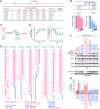HIV-1 competition experiments in humanized mice show that APOBEC3H imposes selective pressure and promotes virus adaptation
- PMID: 28475648
- PMCID: PMC5435363
- DOI: 10.1371/journal.ppat.1006348
HIV-1 competition experiments in humanized mice show that APOBEC3H imposes selective pressure and promotes virus adaptation
Erratum in
-
Correction: HIV-1 competition experiments in humanized mice show that APOBEC3H imposes selective pressure and promotes virus adaptation.PLoS Pathog. 2017 Sep 7;13(9):e1006606. doi: 10.1371/journal.ppat.1006606. eCollection 2017 Sep. PLoS Pathog. 2017. PMID: 28880964 Free PMC article.
Abstract
APOBEC3 (A3) family proteins are DNA cytosine deaminases recognized for contributing to HIV-1 restriction and mutation. Prior studies have demonstrated that A3D, A3F, and A3G enzymes elicit a robust anti-HIV-1 effect in cell cultures and in humanized mouse models. Human A3H is polymorphic and can be categorized into three phenotypes: stable, intermediate, and unstable. However, the anti-viral effect of endogenous A3H in vivo has yet to be examined. Here we utilize a hematopoietic stem cell-transplanted humanized mouse model and demonstrate that stable A3H robustly affects HIV-1 fitness in vivo. In contrast, the selection pressure mediated by intermediate A3H is relaxed. Intriguingly, viral genomic RNA sequencing reveled that HIV-1 frequently adapts to better counteract stable A3H during replication in humanized mice. Molecular phylogenetic analyses and mathematical modeling suggest that stable A3H may be a critical factor in human-to-human viral transmission. Taken together, this study provides evidence that stable variants of A3H impose selective pressure on HIV-1.
Conflict of interest statement
RSH is a co-founder, shareholder, and consultant for ApoGen Biotechnologies, Inc. The other authors have no conflicts of interest to declare.
Figures





Similar articles
-
The activity spectrum of Vif from multiple HIV-1 subtypes against APOBEC3G, APOBEC3F, and APOBEC3H.J Virol. 2012 Jan;86(1):49-59. doi: 10.1128/JVI.06082-11. Epub 2011 Oct 19. J Virol. 2012. PMID: 22013041 Free PMC article.
-
APOBEC3G and APOBEC3F Act in Concert To Extinguish HIV-1 Replication.J Virol. 2016 Apr 14;90(9):4681-4695. doi: 10.1128/JVI.03275-15. Print 2016 May. J Virol. 2016. PMID: 26912618 Free PMC article.
-
APOBEC3 degradation is the primary function of HIV-1 Vif determining virion infectivity in the myeloid cell line THP-1.mBio. 2023 Aug 31;14(4):e0078223. doi: 10.1128/mbio.00782-23. Epub 2023 Aug 9. mBio. 2023. PMID: 37555667 Free PMC article.
-
Running loose or getting lost: how HIV-1 counters and capitalizes on APOBEC3-induced mutagenesis through its Vif protein.Viruses. 2012 Nov 14;4(11):3132-61. doi: 10.3390/v4113132. Viruses. 2012. PMID: 23202519 Free PMC article. Review.
-
Tumultuous relationship between the human immunodeficiency virus type 1 viral infectivity factor (Vif) and the human APOBEC-3G and APOBEC-3F restriction factors.Microbiol Mol Biol Rev. 2009 Jun;73(2):211-32. doi: 10.1128/MMBR.00040-08. Microbiol Mol Biol Rev. 2009. PMID: 19487726 Free PMC article. Review.
Cited by
-
The Antiviral and Cancer Genomic DNA Deaminase APOBEC3H Is Regulated by an RNA-Mediated Dimerization Mechanism.Mol Cell. 2018 Jan 4;69(1):75-86.e9. doi: 10.1016/j.molcel.2017.12.010. Epub 2017 Dec 28. Mol Cell. 2018. PMID: 29290613 Free PMC article.
-
Perspective: APOBEC mutagenesis in drug resistance and immune escape in HIV and cancer evolution.Ann Oncol. 2018 Mar 1;29(3):563-572. doi: 10.1093/annonc/mdy003. Ann Oncol. 2018. PMID: 29324969 Free PMC article. Review.
-
Correction: HIV-1 competition experiments in humanized mice show that APOBEC3H imposes selective pressure and promotes virus adaptation.PLoS Pathog. 2017 Sep 7;13(9):e1006606. doi: 10.1371/journal.ppat.1006606. eCollection 2017 Sep. PLoS Pathog. 2017. PMID: 28880964 Free PMC article.
-
Comparative Description of the Expression Profile of Interferon-Stimulated Genes in Multiple Cell Lineages Targeted by HIV-1 Infection.Front Microbiol. 2019 Mar 12;10:429. doi: 10.3389/fmicb.2019.00429. eCollection 2019. Front Microbiol. 2019. PMID: 30915053 Free PMC article.
-
A role for gorilla APOBEC3G in shaping lentivirus evolution including transmission to humans.PLoS Pathog. 2020 Sep 10;16(9):e1008812. doi: 10.1371/journal.ppat.1008812. eCollection 2020 Sep. PLoS Pathog. 2020. PMID: 32913367 Free PMC article.
References
-
- Zhang J (2003) Evolution by gene duplication: an update. Trends Ecol Evol 18: 292–298.
-
- Sheehy AM, Gaddis NC, Choi JD, Malim MH (2002) Isolation of a human gene that inhibits HIV-1 infection and is suppressed by the viral Vif protein. Nature 418: 646–650. - PubMed
MeSH terms
Substances
Grants and funding
LinkOut - more resources
Full Text Sources
Other Literature Sources
Medical
Molecular Biology Databases

